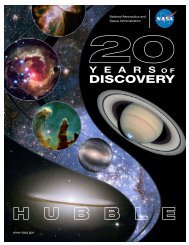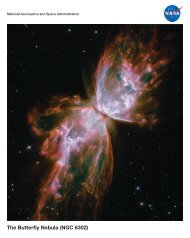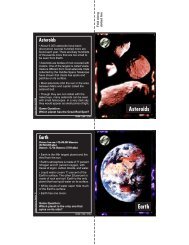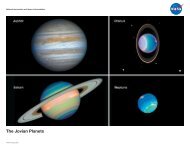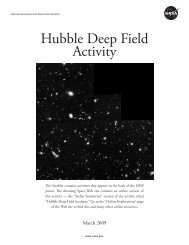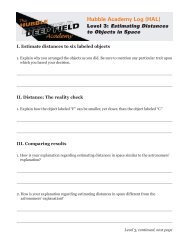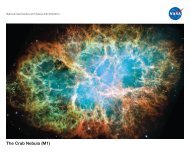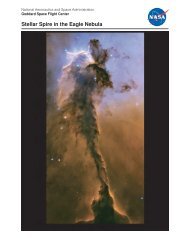Download PDF of story and photos - Amazing Space - STScI
Download PDF of story and photos - Amazing Space - STScI
Download PDF of story and photos - Amazing Space - STScI
- No tags were found...
Create successful ePaper yourself
Turn your PDF publications into a flip-book with our unique Google optimized e-Paper software.
National Aeronautics <strong>and</strong> <strong>Space</strong> AdministrationTHESTARWITNESSA P U B L I C A T I O N O F N A S A ’ S “A M A Z I N G S P A C E ” E D U C A T I O N P R O G R A MSpecial FeatureBirthday Wishes for HubbleBy NASA’s <strong>Amazing</strong> <strong>Space</strong> reportersApril 2007Astronomers areplacing another c<strong>and</strong>le onHubble’s birthday cake. TheEarth-orbiting telescope is celebratingits 17th birthday, making it a mereteenager. This teenager, however, hasproduced some breathtaking images<strong>of</strong> celestial objects <strong>and</strong> has helpedastronomers answer many importantquestions about our universe.A great observatoryNASA launched the Earth-orbitingtelescope on April 24, 1990, whenGeorge W. Bush’s father was president<strong>and</strong> the World Wide Web was still adream. In its 17 years <strong>of</strong> exploring theheavens, the telescope has snappednearly 500,000 images <strong>of</strong> more than25,000 celestial objects. It has madenearly 100,000 trips around Earth.Those trips have racked up lots <strong>of</strong>frequent-flier-miles — more than 2.4billion, the equivalent <strong>of</strong> a round tripto Saturn.Hubble’s 17 years <strong>of</strong> observations haveproduced more than 30 terabytes <strong>of</strong>IMAGE: NASAThe Hubble <strong>Space</strong> Telescope sporting its new solar panels, installed during aservicing mission in 2002. The telescope orbits 380 miles above Earth. Launchedon April 24, 1990, the observatory has been observing the cosmos for 17 years.data, equal to about 25 percent <strong>of</strong>the information stored in the Library<strong>of</strong> Congress. Each day the orbitingobservatory generates about 10gigabytes <strong>of</strong> data, enough informationto fill the hard drive <strong>of</strong> a typical homecomputer in two weeks.Continued, page …
Hubble’s birthday gift to the public: The Carina NebulaIMAGE: NASA, ESA, N. Smith (University <strong>of</strong> California, Berkeley), <strong>and</strong> The Hubble Heritage Team (<strong>STScI</strong>/AURA)The Carina Nebula contains several stars that are among the hottest <strong>and</strong> most massive known. Each star is about 10 timesas hot <strong>and</strong> 100 times as massive as our Sun. The energy produced by these stars is sculpting the nearby gas <strong>and</strong> setting <strong>of</strong>fthe formation <strong>of</strong> a new generation <strong>of</strong> stars.Continued from page …The Hubble archive sends about66 gigabytes <strong>of</strong> information eachday to astronomers throughoutthe world. Astronomers usingHubble data have published nearly7,000 scientific papers, makingit one <strong>of</strong> the most productivescientific instruments ever built.Hubble’s birthday giftto the publicTo celebrate Hubble’s 17th birthday,NASA <strong>and</strong> the <strong>Space</strong> Telescope ScienceInstitute are releasing an image <strong>of</strong> theCarina Nebula, a 3-million-year-oldgigantic cloud <strong>of</strong> gas. The gaseouscloud is a busy star-making factorythat is churning out tens <strong>of</strong> thous<strong>and</strong>s<strong>of</strong> stars. Peeking inside the star-makingfactory, the Hubble <strong>Space</strong> Telescope<strong>of</strong>fers a dramatic glimpse <strong>of</strong> a fairytalel<strong>and</strong>scape <strong>of</strong> dust <strong>and</strong> gas that is beingsculpted by energetic young stars.Looking near <strong>and</strong> farThis jaw-dropping image is justthe latest <strong>of</strong> Hubble’s manyaccomplishments. During its 17years in space, Hubble lookedclose to home at our solar systemplanets, gazed far across space to seegalaxies in their infancy, provideddecisive evidence for the existence<strong>of</strong> giant black holes, <strong>and</strong> detectedan invisible force that makes up thebulk <strong>of</strong> the energy in our universe.Planets, planets everywhereIn our solar system neighborhood,the telescope witnessed pieces <strong>of</strong>a broken-up comet smash intoJupiter, giving the planet several“black eyes.” Hubble also spiedtwo new moons orbiting Pluto.Peering at stars near the center <strong>of</strong> ourMilky Way Galaxy, Hubble conducteda census <strong>of</strong> Jupiter-sized planets. Thetelescope found 16 alien worlds,suggesting that there may be billions <strong>of</strong>Jupiter-sized planets in our galaxy.Witnessing stellar deathTurning its gaze to aging stars, Hubbletook snapshots <strong>of</strong> the “last hurrahs” <strong>of</strong>Sun-like stars. As ordinary stars beginto die, they shed their outer layers <strong>of</strong>gas <strong>and</strong> glow as planetary nebulae. Thetelescope also watched the aftermath<strong>of</strong> a supernova, the explosive death<strong>of</strong> a massive star (see images, page 3).The Hubble observations <strong>of</strong> Supernova1987A helped astronomers rewrite thetextbooks on exploding stars.Continued, page …
Continued from page …Galaxies give up their secretsHubble helped astronomers calculatea precise age for the universe bymeasuring the distances to manygalaxies. Astronomers now think thecosmos is about 13.7 billion years old.Galaxies are everywhere in space,but Hubble looked far acrossour cosmos to see their buildingblocks. The Hubble observationsprovided solid evidence thatgalaxies grew over time to becomethe giant galaxies we see today.Peering into the hearts <strong>of</strong> galaxies,Hubble provided decisive evidencethat supermassive black holes residein many <strong>of</strong> them. These “eatingmachines” gobble up any material thatventures near them. Black holes cannotbe seen directly because no material,including light, escapes their grasp.Shedding light on dark energyBy witnessing bursts <strong>of</strong> light fromfaraway exploding stars, Hubblehelped astronomers discover thata mysterious, invisible force calleddark energy exists. The observationsshow that dark energy is making theuniverse exp<strong>and</strong> at an ever-faster pace.Physicist Albert Einstein predictedits existence early last century, but helater said that his prediction was thebiggest mistake <strong>of</strong> his career. Now,astronomers are proving that Einsteinmay have been right.Although teenage Hubble hasaccomplished so much during its17 years in space, its best scientificdiscoveries are yet to come. NASA isplanning another servicing missionto keep Hubble operating for afew more years. Servicing missionastronauts will install two br<strong>and</strong>new science instruments that willallow Hubble to probe even fartherinto space. Who knows what secretsthe telescope may uncover.Hubble monitors a supernova light show1994 1998 2001The Hubble telescope has taken manypictures over its lifetime <strong>of</strong> thetattered remains <strong>of</strong> an exploded star,called Supernova 1987A.Astronomers first spotted the stellarblast 20 years ago, in 1987. Thesesix Hubble snapshots, taken overseveral years, show a growing number<strong>of</strong> bright spots on a ring <strong>of</strong> materialaround the exploded star. Debris fromthe supernova is slamming into thering <strong>and</strong> lighting it up.2003 2004 2006IMAGES: NASA, ESA, P. Challis <strong>and</strong> R. Kirshner (Harvard-Smithsonian Center for Astrophysics)
Hubble’s Top Science (<strong>PDF</strong>)READ MORE <strong>and</strong> see thepictures that accompanyHubble’s top scientific findingsafter 17 years in orbit.<strong>Download</strong> the <strong>PDF</strong> fromamazing-space.stsci.edu/news/archive/2007/02/extra-03.php.SEE MORE Hubble images <strong>and</strong> read moreStar Witness news stories at <strong>Amazing</strong> <strong>Space</strong>,NASA’s award-winning educational Web site forK-12 students <strong>and</strong> teachers.amazing-space.stsci.eduwww.nasa.gov



